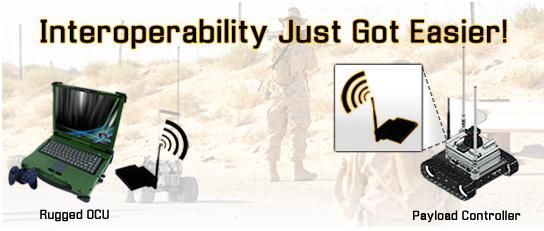The US Army has announced plans to increase the autonomy of its Unmanned Ground Vehicles (UGVs). “We are moving along that spectrum from tele-operating to semiautonomy where you can send a robot from point A to point B without any intervention,” said U.S. Marine Corps Lt. Col. David Thompson, project manager with the Robotic Systems Joint Program Office (Army building smarter robots). To read the rest of the article, please click here.
Unmanned Ground Vehicles (UGVs). “We are moving along that spectrum from tele-operating to semiautonomy where you can send a robot from point A to point B without any intervention,” said U.S. Marine Corps Lt. Col. David Thompson, project manager with the Robotic Systems Joint Program Office (Army building smarter robots). To read the rest of the article, please click here.
Ground Robotics Capabilities Conference 2011 Report
Mike Castillo, AMREL’s Senior Architect for Robot Applications, just came back from the Ground Robot Capabilities Conference with all sorts of news.
“Research and development is out,” he reported. “Budget priorities have changed. DoD wants existing technologies with a small form factor that’s light and available right now.”
This news made AMREL happy since our product line is mature and even our new solutions are based on proven technologies. For example, at the conference, we successfully demonstrated our new payload controller. Based on the battlefield-tested Flexpedient technology, this payload solution is the first one with interoperable capabilities.
Future blog posts will feature more news about this year’s conference, our new payload controller, as well as other new AMREL solutions.
For more information about Flexpedient and interoperable solutions, watch the video on the Flexpedient page.

Do I need a hi-bright display?
Brighter is not always better. It’s true that hi-bright displays are
more visible outdoors. However, they also use a lot of power. While this can be compensated for with appropriate power management schemes, an overly bright display can be a problem for a demanding application that relies heavily on batteries. When more power is used, more heat is generated. So heat-sinking needs to be looked at as well. Don’t forget about the other end of the brightness scale. That bright display may need to be ratcheted down a lot to work with night-vision goggles.
AMREL at the Ground Robotics Capabilities Conference
March 22 – 24, 2011 – Orlando, Florida – Booth #112

Flexpedient® Technology now extends existing radio modules’
capabilities to both our OCUs AND payload controllers
Come see AMREL’s latest platforms, including:
- New 986 series laptops with standard Flexpedient device bays
- Atom-based handheld computers & OCUs
- Up-to-minute OCU form factors
To find out about AMREL’s hospitality suite, contact Mike Castillo at:
Office: (626) 443-681, ext 190
Cell: (626) 482-8791
Email: michaelc@amrel.com
If the Frankenstein monster was tasked with analyzing the world’s Defense budgets, he would pour over mountains of paperwork and then in his famously concise manner, utter the following: “Robots Good. People Bad.”
The monster’s short summary can be supported by looking at two different kinds of Defense budgets, those that are increasing and those that are shrinking.
can be supported by looking at two different kinds of Defense budgets, those that are increasing and those that are shrinking.
In spite of what you may have heard about Secretary Gates’ highly publicized “efficiencies,” the US Defense budget, in real terms, is increasing. The President will ask for a $553 million for the non-war 2012 allocation, a 5% increase over the 2011 budget (Market Watch U.S. budget spat worries military contractors). This is after a 2011 budget request that was 2.4% larger than the previous year (Center of Strategic and Budgetary Assessments Analysis of the FY 2011 Defense Budget) Read more
The modern battlefield is full of robots all talking at once. Unmanned systems consume significant amounts of communications bandwidth because they require transmission of control signals and large amounts of sensor data. Line-of-sight (LOS) limitations often obstruct high frequency digital radio communications. In addition, encryption, which is necessary for security, can decrease operational distance.
Besides compromising range, radio noise may also affect how the robots respond toinstructions, even instigating false commands. Another consideration is the additional power consumption necessary to burst through interference.
Different types of unmanned systems have specific radio communication challenges….
Click here to read the rest of the article.
If you’re like me, you may have thought that the US Military adopted network-centric warfare in the current conflicts, so it could leverage its technological advantage. This widespread application of information technology as a unifying doctrine for warfighting was the culmination of a debate that began in January 1998, when the journal Proceedings published “Network-Centric Warfare: Its Origin and Future” by Vice Admiral Arthur K. Cebrowski and John J. Garstka.
If the only thing you ever read was General McChrystal’s It Takes a Network, published in Foreign Policy, you might think that the commanders in theater adopted network-centric warfare—not because of years-long deliberation within the DoD— but because al-Qaeda, adopted it first.
General McChrystal describes the enemy as being able to “… leverage sophisticated technology that connects remote valleys and severe mountains instantaneously — and allows them to project their message worldwide, unhindered by time or filters. They are both deeply embedded in Afghanistan’s complex society and impressively agile. And just like their allies in al Qaeda, this new Taliban is more network than army, more a community of interest than a corporate structure.”
Early in his command in Iraq, McChrystal drew a diagram illustrating the bottleneck that prevented the free flow of data among the highly compartmentalized structures of U.S. forces. This bottleneck contrasted greatly with the al Qaeda’s easy exchange of information, which enabled it to maintain a lateral structure, quick adoption of successful tactics, and independent operations.
“The sketch from that evening — early in a war against an enemy that would only grow more complex, capable, and vicious — was the first step in what became one of the central missions in our effort: building the network. What was hazy then soon became our mantra: It takes a network to defeat a network.”
This is an inspiring story, depicting the flexibility and ingenuity of our military determined to complete its mission under difficult circumstances. McChrystal’s article is well-written and I strongly recommend it.
However, it is not correct to say the U.S. network-centric warfare efforts began with McChrystal’s diagram. Award-wining Noah Shachtman writing in “How Technology Almost Lost the War: In Iraq, the Critical Networks Are Social — Not Electronic” for Wired.com, reports that the principles of network-centric warfare were adopted and applied as early as the 2003 invasion of Iraq. In fact, they worked pretty well —during the invasion. The problems occurred during the occupation and rebuilding.
Shachtman writes “… Cebrowski and Garstka weren’t really writing about network-centric warfare at all. They were writing about a single, network-enabled process: killing.” In counter-insurgency, killing is not the same thing as warfare. So, the DoD’s application of network-enabled killing was great for using Special Operation teams to target and eventually destroy SCUD missiles. Not so great for nation building.
Under McChrystal and Petraeus’ leadership, the U.S. led forces in Iraq and Afghanistan altered their internal social culture about intelligence distribution as well as built social networks with the locals. Shachtman is persuasive that the social networks with the inhabitants are more significant than electronic. Even Garstka admitted to Shachtman, “You have your social networks and technological networks. You need to have both.”
Just as McChrystal did, we need to change our attitudes in order to properly exploit the advantages of networks. This applies not only to the military, but to the community supplying them. Contractors and sub-contractors need to overcome their traditional hostility with competitors and network with each other in order provide the best-possible solutions. Nowhere is this more apparent than in the issue of interoperability, which is essential for true network-centric warfare.
In “UAV Implementation at the Infantry Platoon Level” (Military & Aerospace), the author reported “I spent 2 ½ years over 2 deployments to Iraq as an Infantryman and we rarely had good UAV support. When we did have UAV support, it was not always ‘top of the line’ because the operators were FOB based and it was an office job that became a ‘check the block’ duty.” The author complained that UAVs were not being “pushed down to the platoon level,” because “…most Commanders are concerned about losing platoon level UAVs.”
His comments about the implementation of UAVs are an interesting example of how Human Robot Interaction (HRI) difficulties frustrate the proper implementation of novel technology. From the very beginning of the introduction of unmanned systems into the battlefield, there has been a debate about the best positioning of human operators. For the most part, a consensus has emerged that the dangers posed to operators in the front lines are outweighed by the advantages of close coordination with forward-placed warfighters.
In this instance, UAV deployment was influenced not by concerns about the operators, but–according to the author- by fear of losing valuable equipment. Clearly, these commanders hadn’t gotten the memo that the point of unmanned systems is to assume risk, so the troops don’t have to.
Livescience.com in “Real Soldiers Love Their Robot Brethren” reveals that other soldiers also haven’t gotten this memo. Quoting Peter Singer (author of “Wired for War: The Robotics Revolution and Conflict in the 21st Century”), they describe a “… soldier who ran 164 feet under machine gun fire to retrieve a robot that had been knocked out of action.”
The phenomenon of soldiers risking their lives for robots was also reported in “Why Bomb-Proofing Robots Might Be a Bad Idea” (Wired.com). In fact, the author of that article suggests that we should reconsider the ideas of outfitting robots with expensive classified electronic countermeasures, because that “…undermines the purpose of having a disposable army of machines to handle irregular war’s most dangerous work.”
So, in addition to obstructing proper implementation, HRI difficulties affect actual combat. A great deal of research has been done on HRI, but human behavior has a way of confounding even the most dedicated researcher.
Even the User Interface (UI) itself can cause unanticipated problems. In an article to be published in the March OCU Pros newsletter, David Bruemmer, VP of R&D at 5-D Robotics reveals some unexpected problems with commonly used UIs. Simply put, video feeds and other information-rich UIs may actually be detrimental to the operation of an unmanned system (To read this article and receive the OCU Pro newsletter, sign up here).
The unpredictability of how humans interact with robots may frustrate the drive to field novel technology as fast as possible. This obstacle emphasizes the rather unsurprising idea that end-user input is important early in the development process (At least it should be unsurprising to anyone who reads this blog).
Of course, not all unpredictable human interactions with robots have dire consequences. Check out this video of a “weaponized” BigDog robot being used in ways that the designers surely never envisioned.
In a recent posting (Network-centric Warfare: Dead or Alive ?), I wrote about the debate concerning network-centric warfare. In the wake of the “reorganization” and outright elimination of high-profile initiatives and programs associated with network-centric warfare, Defense vendors are anxiously wondering if it  will persist as a central doctrine for transforming the military.
will persist as a central doctrine for transforming the military.
Clearly, the military’s obsession with connectivity is far from over. DARPA is actively working to overcome the military’s traditional anxiety about the security of distributed servers (Pentagon Looks to Militarize the Cloud). The Army is running a contest for mobile applications and talking about issuing smartphones to every soldier (A Smart Phone for Every Soldier?). Solutions are being displayed for sticking 3G cellular pods on a variety of vehicles, including UAVs (Forward Airborne Secure Transmissions and Communications).
So the forces that spawned network-centric warfare are still active, but as I concluded in the above-referenced blog post, so are the problems that have frustrated its implementation. Here’s a partial list of obstacles
- Money
- Lack of interoperability
- Money
- Development and acquisition pipeline logjam
- Money
According to at least one analysis, the current cost-climate climate means “… that the personnel and procurement budgets will be reduced to pay for O&M costs…” (Defense Industry Daily). As the demand for novel technology grows, acquisition budgets shrink. Defense wants the latest and greatest solutions, they want them now, and they want them to have a TRL level of 9 before they even see them. Government paying for research, testing, validation and verification? That’s so 20th century.
Using mature systems to develop advanced, useful solutions for today’s challenges is not impossible. Working with strategic partners, AMREL has developed System One, a Last Tactical Mile solution, a system composed of entirely battle-proven technology.
“The Last Tactical Mile” is a classic problem of network-centric warfare. Front-line troops are demanding real-time information. The days are over when data for C4ISR (Command, Control, Communications, Computers, Intelligence, Surveillance and Reconnaissance) only went to the “back-end” (headquarters located away from the front). However, getting this information into hands of the warfighter is a tremendous problem.
To appreciate the complexities of “The Last Tactical Mile,” imagine a team of Marines attacking a high value target in littoral waters. They might be deployed on an amphibious assault vehicle (whatever replaces the now-canceled Expeditionary Fighting Vehicle). In theory, this scenario could require connectivity among a UAV, external ship sensors, satellite networks, the amphibious assault vehicle, mother ship personnel, and the strike team deployed. Space is limited aboard the ships and all equipment must be ruggedized in order to withstand the harsh maritime and combat environments.
System One leverages AMREL’s broad range of from-factors for mature computing platforms, which are more than rugged enough to withstand the brutal vibrations of the high-speed landing craft, the corrosive conditions of the sea, as well as the violent realities of warfighting. AMREL’s durable, battle-tested PDAs are ideal for the Marine strike team. AMREL’s portable, rugged tablets could maintain communication with the amphibious assault vehicle’s coxswain as well as the mother ship’s onboard crew. Our fully functional 19/2® servers are1/4 the size of normal rack-mounted units, so they’re perfect for the cramped quarters of the assault vehicle. Designed to be flexible and to maximize connectivity, AMREL’s computers would have no problem tying the whole thing together with a MESH network.
System One has already successfully demonstrated the connectivity and reliability required for such a scenario. It can be installed on any vehicle, land or sea. It would function perfectly in the high-speed Stiletto boat and is small enough to fit in even the most crowded MRAP vehicle. In fact, it’s so compact, it is even man-portable.
An example of an advanced solution using mature, field-tested components, System One demonstrates that with careful strategic teaming and a bit of imagination, diminished government resources for research and testing can be leveraged into an opportunity.
For a more detailed discussion of “The Last Tactical Mile” and System One, please see IDGA’s interview with Luke McKinney, an expert in military intelligence operations and joint mission analysis.
American Reliance, Inc.
789 N Fair Oaks Ave,
Pasadena, CA 91103
Office Hours
Monday-Friday:
8:00 am – 5:00 pm PST
Saturday: Closed
Sunday: Closed
Main: +1 (626) 482-1862
Fax: +1 (626) 226-5716
Email: AskUs@amrel.com
Blog Posts
Mobile Biometric Solutions
Mobile Biometric Smartphones & Tablets
BioFlex S® Commercial Smartphones
BioSense AT80B | 8″ Android Biometric Tablet
BioSense PA5 | 10.1″ (Gen 2) Android Biometric Tablet
BioSense PA5 | 10.1″ Android Biometric Tablet
BIOPTIX PM3B | 7″ Windows Biometric Tablet
BIOPTIX PM5B | 10.1″ Windows Biometric Atom Tablet




